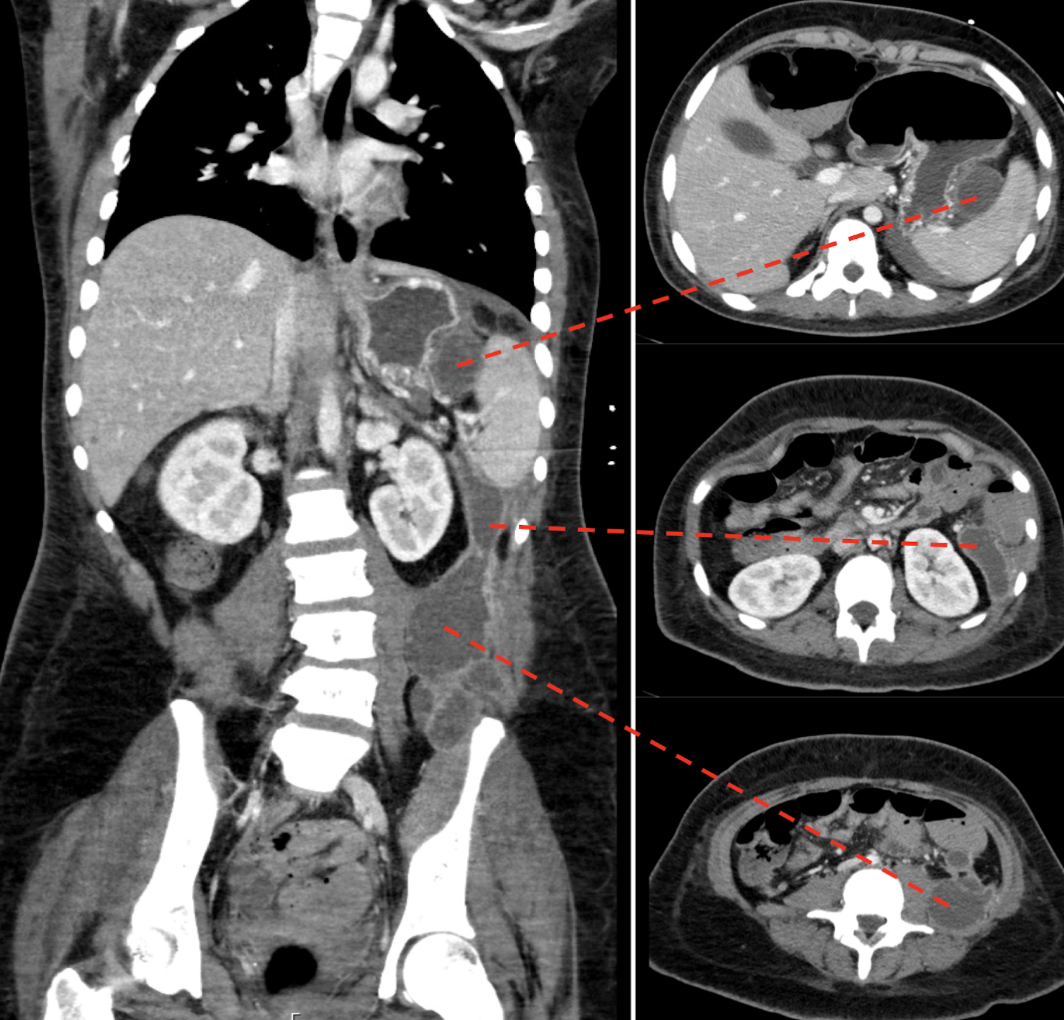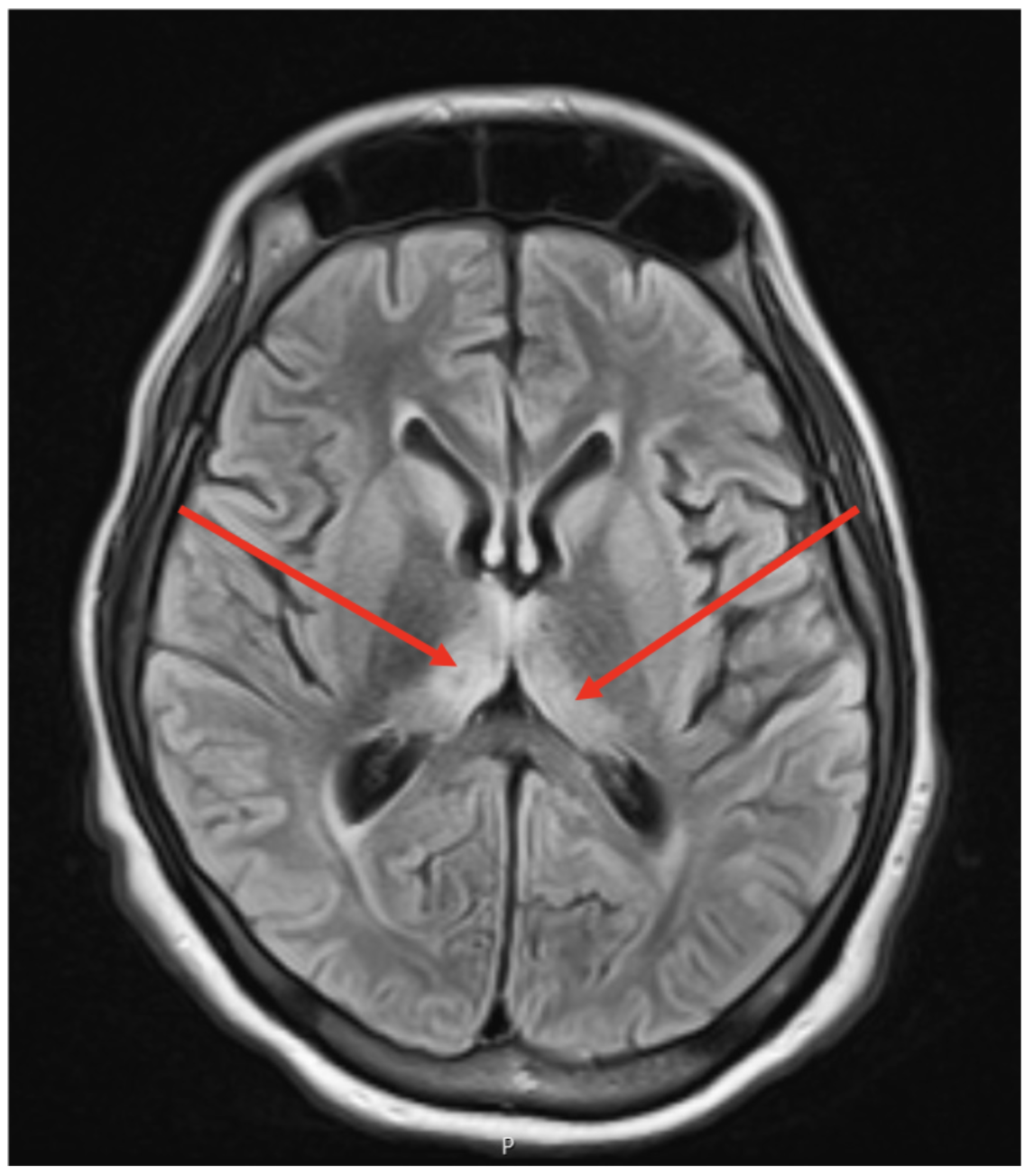Sunday Poster Session
Category: Diet, Nutrition, and Obesity
P0572 - A Dangerous Cascade: Valproic Acid-Induced Necrotizing Pancreatitis With Wernicke Encephalopathy and Intrathalamic Hemorrhage
Sunday, October 26, 2025
3:30 PM - 7:00 PM PDT
Location: Exhibit Hall

Bilind S. Ismail, MD (he/him/his)
Willis Knighton Health
Shreveport, LA
Presenting Author(s)
Bilind Ismail, MD1, Michael Chammany, DO2, Shriya Vudari, MD3, Ahmed Virani, MD4
1Willis Knighton Health, Shreveport, LA; 2Edward Via College of Osteopathic Medicine, Galveston, TX; 3Louisiana State University, Shreveport, LA; 4Willis Knighton Medical Center, Shreveport, LA
Introduction: Valproic acid (VPA) is widely used to treat various seizure disorders such as epilepsy, though one of its most notable adverse effects is acute pancreatitis. While cases of acute pancreatitis progressing to necrotizing pancreatitis are well-documented, instances of Wernicke Encephalopathy arising from pancreatitis-induced thiamine deficiency are comparatively rare2.
Case Description/
Methods: An 18-year-old male with a history of autism and epilepsy managed with VPA presented to the emergency room one month after the initiation of VPA due to severe abdominal pain. Lab results showed elevated amylase and lipase levels and with an abdominal CT scan showing pancreatitis. Despite initial conservative management, he developed necrotizing pancreatitis with the formation of a large pseudocyst necessitating percutaneous drainage. Following the procedure, the patient was discharged to a long-term acute care facility. After 5 months, he presented to the emergency room again due to hypotension, altered mental status and abdominal pain.New CT of the abdomen and pelvis revealed recurrent infected pancreatic pseudocysts that ultimately required admission to the ICU because of hypotension necessitating norepinephrine, fever management, broad spectrum antibiotic administration, and the placement of two additional percutaneous drainages Patient’s respiratory function slowly deteriorated while he was staying in the ICU, ultimately requiring intubation. Six days later, he developed loss of respiratory drive, absent direct gag and cough reflexes, and unresponsiveness despite being off of all sedatives. A brain CT showed an acute intraparenchymal hemorrhage within the right thalamus extending into the third ventricle, and an MRI of the brain showed severe manifestation of Wernicke Encephalopathy accompanied by hemorrhage likely due to critical illness and nutritional deficiencies secondary to necrotizing pancreatitis.
Discussion: Valproic acid (VPA)–induced pancreatitis is a rare but potentially life-threatening adverse effect. We present a case of VPA-induced pancreatitis that progressed to necrotizing pancreatitis with pancreatic pseudocyst formation, unresponsive to standard drainage procedures. The prolonged course of illness led to significant nutritional compromise This case highlights not only the further need for investigation into the pathophysiology of VPA-induced pancreatitis, but also the importance of considering thiamine deficiency in patients with prolonged vomiting and malnutrition.

Figure: Figure A: Coronal and axial views of the 9/15 repeat abdominal CT showing multiloculated fluid collections within the left retroperitoneum.

Figure: Figure B: Brain MRI 9/23 showing signal alteration with associated restricted diffusion along the medial aspect of the thalamus bilaterally, suggestive of Wernicke Encephalopathy.
Disclosures:
Bilind Ismail indicated no relevant financial relationships.
Michael Chammany indicated no relevant financial relationships.
Shriya Vudari indicated no relevant financial relationships.
Ahmed Virani indicated no relevant financial relationships.
Bilind Ismail, MD1, Michael Chammany, DO2, Shriya Vudari, MD3, Ahmed Virani, MD4. P0572 - A Dangerous Cascade: Valproic Acid-Induced Necrotizing Pancreatitis With Wernicke Encephalopathy and Intrathalamic Hemorrhage, ACG 2025 Annual Scientific Meeting Abstracts. Phoenix, AZ: American College of Gastroenterology.
1Willis Knighton Health, Shreveport, LA; 2Edward Via College of Osteopathic Medicine, Galveston, TX; 3Louisiana State University, Shreveport, LA; 4Willis Knighton Medical Center, Shreveport, LA
Introduction: Valproic acid (VPA) is widely used to treat various seizure disorders such as epilepsy, though one of its most notable adverse effects is acute pancreatitis. While cases of acute pancreatitis progressing to necrotizing pancreatitis are well-documented, instances of Wernicke Encephalopathy arising from pancreatitis-induced thiamine deficiency are comparatively rare2.
Case Description/
Methods: An 18-year-old male with a history of autism and epilepsy managed with VPA presented to the emergency room one month after the initiation of VPA due to severe abdominal pain. Lab results showed elevated amylase and lipase levels and with an abdominal CT scan showing pancreatitis. Despite initial conservative management, he developed necrotizing pancreatitis with the formation of a large pseudocyst necessitating percutaneous drainage. Following the procedure, the patient was discharged to a long-term acute care facility. After 5 months, he presented to the emergency room again due to hypotension, altered mental status and abdominal pain.New CT of the abdomen and pelvis revealed recurrent infected pancreatic pseudocysts that ultimately required admission to the ICU because of hypotension necessitating norepinephrine, fever management, broad spectrum antibiotic administration, and the placement of two additional percutaneous drainages Patient’s respiratory function slowly deteriorated while he was staying in the ICU, ultimately requiring intubation. Six days later, he developed loss of respiratory drive, absent direct gag and cough reflexes, and unresponsiveness despite being off of all sedatives. A brain CT showed an acute intraparenchymal hemorrhage within the right thalamus extending into the third ventricle, and an MRI of the brain showed severe manifestation of Wernicke Encephalopathy accompanied by hemorrhage likely due to critical illness and nutritional deficiencies secondary to necrotizing pancreatitis.
Discussion: Valproic acid (VPA)–induced pancreatitis is a rare but potentially life-threatening adverse effect. We present a case of VPA-induced pancreatitis that progressed to necrotizing pancreatitis with pancreatic pseudocyst formation, unresponsive to standard drainage procedures. The prolonged course of illness led to significant nutritional compromise This case highlights not only the further need for investigation into the pathophysiology of VPA-induced pancreatitis, but also the importance of considering thiamine deficiency in patients with prolonged vomiting and malnutrition.

Figure: Figure A: Coronal and axial views of the 9/15 repeat abdominal CT showing multiloculated fluid collections within the left retroperitoneum.

Figure: Figure B: Brain MRI 9/23 showing signal alteration with associated restricted diffusion along the medial aspect of the thalamus bilaterally, suggestive of Wernicke Encephalopathy.
Disclosures:
Bilind Ismail indicated no relevant financial relationships.
Michael Chammany indicated no relevant financial relationships.
Shriya Vudari indicated no relevant financial relationships.
Ahmed Virani indicated no relevant financial relationships.
Bilind Ismail, MD1, Michael Chammany, DO2, Shriya Vudari, MD3, Ahmed Virani, MD4. P0572 - A Dangerous Cascade: Valproic Acid-Induced Necrotizing Pancreatitis With Wernicke Encephalopathy and Intrathalamic Hemorrhage, ACG 2025 Annual Scientific Meeting Abstracts. Phoenix, AZ: American College of Gastroenterology.
